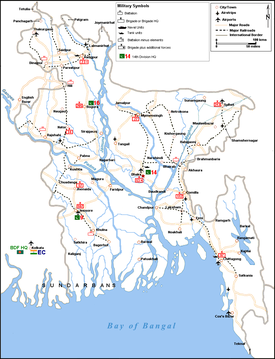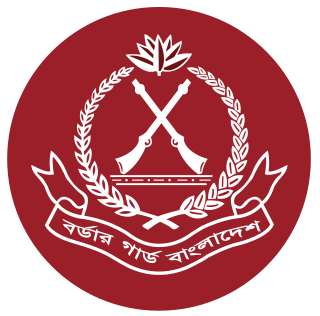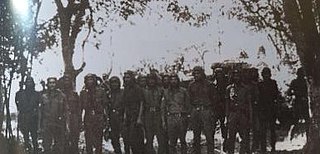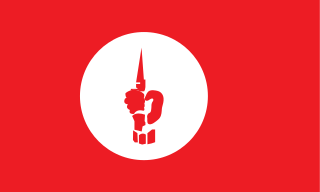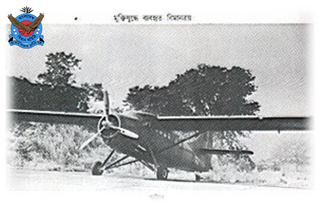General Niazi, along with General Jamshed (GOC EPCAF), General Rahim ( 2IC Eastern Command), Brig. Bakir (COS Eastern Command), Rear Admiral Sharif and Air Commodore Enam reviewed the existing plan and updated it to factor in the manpower shortage, logistical difficulties, and the directive of the GHQ to defend every inch of East Pakistan. [64] [65] The initial assumptions were: [66]
Gen. Niazi chose the Fortresses concept of defence and the planners decided on a single defensive deployment of troops on the border, which went against the troop deployments advocated by the earlier plans. This was done to stick to the GHQ order of not surrendering any territory to the Mukti Bahini.
Defensive lines
Once the fortress defence was chosen, General Niazi and his staff designated the following cities as fortresses: Jessore, Jhenida, Bogra, Rangpur, Comilla and Bhairab Bazar (these were located on communication hubs), Jamalpur and Mymensingh (defending the northern perimeter of the Dhaka bowl), and Sylhet and Chittagong (independent defence areas). There were 4 lines of defence:
1. The troops deployed on the border was the forward line – this was way in front of the forward line envisioned in the X- Sunderban exercise of 1967 – which had deemed the whole border impossible to defend against a conventional attack. [69] The BoPs were all located on this line. 2. The Fortresses: All the fortresses were located on this line except Chittagong and Sylhet – which were to be independent defensive areas. This was the forward line of the 1967 X-Sunderbans plan and it was also deemed indefensible in its entirety in that exercise. 3.Dhaka Outer Defence Line: Troops from the fortresses were to retreat to this line. The line ran from Pabna in the west to Bera then Sirajganj to the north, then to Mymensingh. From Mymensingh the line went south to Bhairab Bazar, from Bhairab it ran southwest along the Meghna to Daudkandi and Chandpur, then ran northwest along Padma then to the Madhumati, along the Madhumati back to Pabna. The fortresses of Bhairab and Mymensingh was part of this line. Pabna, Bera, Chandpur, Daudkandi and Faridpur was to be turned into fortresses, while Kamarkhali, Goalanda, Nagarbari and Narshindi were to be strong points. Faridpur and Narshindi were turned into strong points when the attack was begun in December, the rest of the sites were not built up. 4.Dhaka Inner Defense Line: This ran from Manikganj in the west to Kaliakair, on to Tongi, then to Naryanganj and from Naryanganj back to Manikganj. This area was to have a fortress – Naryanganj and strong points at Kalaikair and Tongi. None were developed by December 1971.
Having chosen the defensive concept and defensive lines, Pakistan Eastern Command outlined the course of action as follows:
- Troops deployed on the border would hold on till ordered to retreat by the GOC
- Troops would 'Trade space for time' and fight a delaying action while falling back to the nearest fortress
- The fortress would be defended to the last – which was understood until a certain amount of time needed for Pakistan to deliver the knockout blow in the west.
- The troops formations would fall back to the Dhaka outer line to defend Dhaka as needed.
The divisional commanders were authorised to make plans for limited counterattacks in Indian territory to aid in their defensive objectives, which was to maintain control of the main pathways leading into the province.
Assumed enemy axis of attack and Pakistani deployments
Pakistani planners assumed, based on intelligence estimates, that an Indian force of 8 to 12 infantry divisions and an armoured brigade, along with the Mukti Bahini would launch the invasion of East Pakistan in winter. Pakistan army had broadly divided the country into 4 sectors, and the Pakistani deployments were: [70] [71] [72]
Northern Sector (Indian designation: North Western Sector): This area is to the north of Padma and West of Jamuna rivers, encompassing the Rajhshahi, Pabna, Bogra, Rangpur and Dinajpur districts. Pakistani planners were undecide on whether the Indian attack would come from the Siliguri Corridor south towards Bogra or on the Hili – Chilimari axis from southwest to northeast to cut the area in two. The 16th Infantry division (CO Maj. Gen. Nazar Hussain Shah, HQ Bogra then Nator) was deployed to counter both possibilities. [73]
The 23rd Brigade (CO brig. S.A Ansari) was to defend the area north of Hili – Chilmari axis. The troops were to retreat to Dinajpur, Saidpur and Rangpur from the border areas, while Dinajpur, Saidpur, T-Junction and Thakurgaon were turned into strongpoints. The area north of the Tista River was a separate defence area, where the 25th Punjab, 86th Mujahid, 1 wing EPCAF and the independent heavy mortar battery was located.
The 205th Brigade (CO Brig. Tajammul Hossain Malik) would defend the area between Hili (a strongpoint) and Naogaon then fall back to Bogra (fortress) and hold out. Palashbari, Phulchari and Joyporhut were turned into strongpoints. The 34th Brigade (CO Brig. M.A. Nayeem) would look after the area between Rajshahi and Naogaon, and if need would fall back to the Outer Dhaka defence line and defend from Pabna and Bera, both proposed fortresses. In September, an ad hoc brigade was formed in Rajshahi to block the Padma from any enemy riverine operations. [74]
Western Sector (Indian designation: Western Sector): The area south of the Padma and east of the Meghna contained the Khulna, Jessore, Kushtia, Faridpur, Barisal and Patuakhali districts and was defended by the 9th Division (CO Maj. Gen. Ansari) made up of 2 infantry brigades: the 107th (CO Brig. Makhdum Hayat, HQ Jessore), covering the border from Jibannagar to the Sunderbans to the south, and the 57th (CO Brig. Manzoor Ahmed, HQ Jhenida), which covered the border from Jibannagar to the Padma in the north. Pakistani planners assumed three likely axis of advance from the Indian army: [75] [76]
- The main attack would come in the Calcutta – Banapol – Jessore axis. The 107th Brigade was tasked with guarding the Benapol axis.
- Another thrust would be made either using the Krishnanagar – Darshana – Chuadanga axis, or the Murshidabad – Rajapur – Kushtia axis. The 57th Brigade (18th Punjab and 29th Baloch) was deployed to cover the Darshana and Meherpur area. To defend the Hardinge Bridge, a tank squadron was placed under Eastern Command control near Kushtia.
In September, an ad hoc brigade, the 314th, [77] (CO Col. Fazle Hamid, one Mujahib battalion, and 5 companies each from EPCAF and Razakars) was created to defend the city of Khulna. [78]
The 57th and 107th brigades were to defend the border then fall back to Jhenida and Jessore, and prevent the enemy from crossing the Jessore –Jhenida road, which runs almost parallel to the border. The brigades also had the option to fall back across the Madhumati river, which formed part of the Dhaka outer defense line, and defend the area between Faridpur, Kamarkhali and Goalanda.
The 14th Division initially had 4 brigades: the 27th (CO Brig. Saadullah Khan, HQ Mymensingh), 313th (Brig Iftikar Rana, HQ Sylhet), the 117th (Brig. Mansoor H. Atif, HQ Comilla) and the 53rd (Brig. Aslam Niazi, HQ Dhaka) and looked after the rest of the province. It was decided in September to make the 14th responsible for the eastern sector encompassing Sylhet, Comilla and Noakhali districts only, while the 36th ad hoc division was remade responsible for the Dhaka Bowl.
Dhaka Bowl (Indian designation: North Eastern Sector): Pakistani planners anticipated a brigade size attack on the Kamalpur – Sherpur – Jamalpur axis and another along the Haluaghat – Mymensingh axis. [79] They deemed this area was impassable because of the hilly terrain on the Indian side and the Modhupur Jungle and the Brahmaputra river to the north of Dhaka. Pakistani deployment in this sector was: [80] [81] 93rd brigade was responsible for the border area between the Jamuna river and Sunamganj. It developed strong points at Kamalpur, Haluaghat and Durgapur, while Jamalpur and Mymensingh were turned into fortresses. The course of the Brahmaputra rives was designated as the "line of no penetration".
53rd brigade was posted in Dhaka as command reserve [82] and was responsible for the Dhaka inner defence line until it was moved to Feni. [83] Dhaka city also had Razakar, EPCAF and other units that could be deployed for defence of the city.
Eastern Sector (Indian designation: South Eastern Sector): This sector included the Chittagong, Noakhali, Comilla and Sylhet districts. The anticipated lines of advance were: [84] [85]
- Agartala – Akhaura – Bhairab Bazar axis would be the main thrust, with another attack coming towards Moulvibazar – Shamshernagar and third near Comilla.
The 14th Division (CO: Maj. Gen. Rahim Khan, then Maj. Gen Abdul Majid Kazi) was initially HQed at Dhaka until the creation of the 36th ad hoc division to cover the Dhaka Bowl, when its HQ moved to Brahmanbaria. Chittagong was designated as an independent defence zone under control of the 97th independent brigade. Also, two ad hoc brigades were created, the 202nd and the 93rd out of the units of the 14th division. [86] The division order of battle after September was: [87] [88]
202nd ad hoc brigade (CO Brig. Salimullah, HQ Sylhet) was responsible for the border stretching from Sunamganj to the north west of Sylhet to Latu to the east of that city. Sylhet was designated as a fortress. [89] The 313rd Brigade (CO Brig. Iftekhar Rana), Hqed at Moulvibazar, which was developed as a strong point and the unit was responsible for the border between Latu and Kamalganj. After resisting the expected enemy thrust along the Moulvibazar – Shamshernagar front, the brigade was to move south and link up with the 27th Brigade near Brahmanbaria. Gen Niazi also envisioned this brigade launching an assault inside Tripura if possible. [90]
The 27th Brigade (CO Brig. M. Saadullah) was responsible for covering the border between Kamalganj and Kasba, just north of Comilla, and would block the expected main enemy axis of advance, with strong points at Akhaura and Brahmanbaria. Brig. Saadullah anticipated a 3 pronged assault on his area around Akhaura and planned to ultimately fall back to Bhairab, which was the nearest fortress and part of the Dhaka outer defence line.
The 117th Brigade (CO Brig. S.M. Attif, Hqed at Mainamati) was responsible for the border between Kasba to the north of Comilla (a fortress) to Belonia in Noakhali. It was to concentrate near Comilla in the event of an Indian advance, then fall back to Daudkandi and Chhandpur, which were part of the Dhaka outer defence line and designated "Fortresses".
The 97th independent Infantry Brigade (CO Brig. Ata Md. Khan Malik, HQ Chittagong) was to cover the Chittaging fortress and Chittagong hill tracks.


